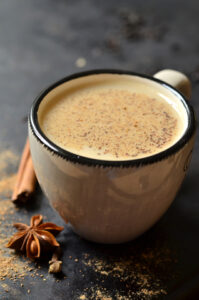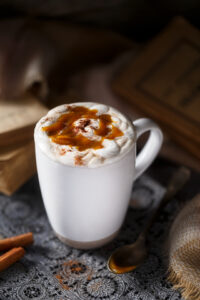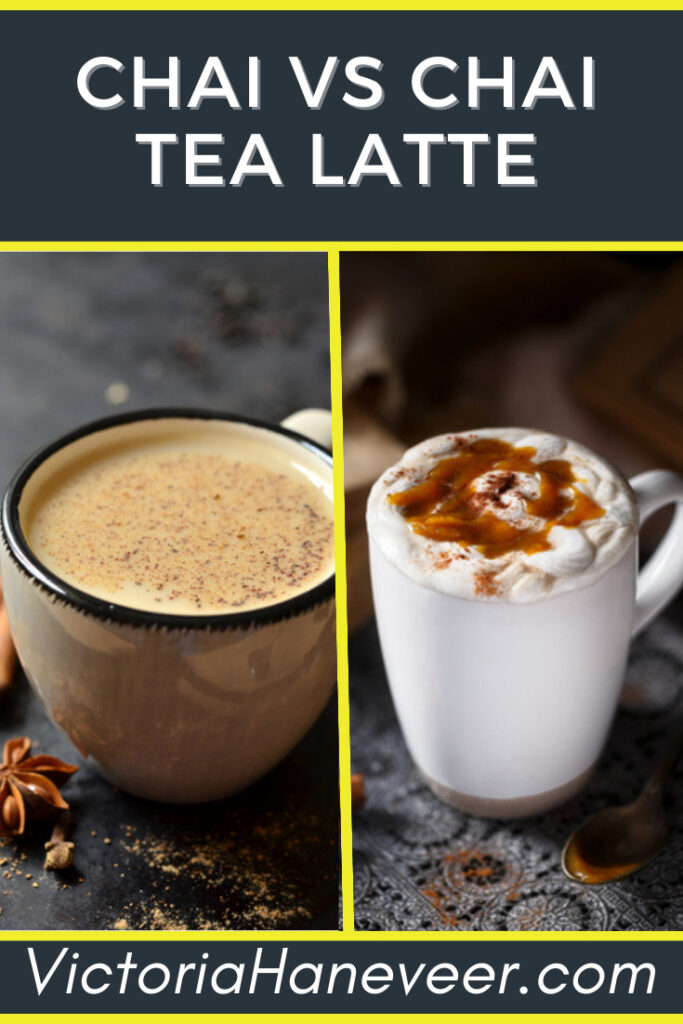Chai vs chai latte: aren’t these different terms for the same drink? Actually no, although they do share similarities. Let’s look at each of these terms to discover what the differences are, and which one you should make or order.
If you’re a tea aficionado like me (well, I am British!) you might also enjoy Thai tea, different kinds of Chinese tea and even recipes using it, such as Chinese tea smoked chicken.
My go-to tends to be Twining’s brand English Breakfast with a splash of milk, or sometimes Earl Grey, although I love most teas and love trying new ones. Anyway, lets focus on chai vs chai latte and find out the difference between them.
Table of Contents
What is Chai?
What’s the history of chai tea? Well, chai is the Hindi word for tea, which comes from “cha” – the Chinese word for tea. Chai refers to various spices brewed in a tea-based drink.
There are many recipes though, with different spices and different amounts of them. The basic recipe is different wherever you go, but traditionally you would expect black tea, cardamom, cinnamon, ginger, cloves, and black peppercorns. Milk is typically added too, as is sugar or honey.
Apparently chai tea has been made for more than 5000 years. The king in the country known as India now requested a spiced drink with Ayurveda-friendly spices such as cardamom for mood, cinnamon for respiratory and circulatory aid, black pepper and ginger for healthy digestion, and pain-relieving cloves. Star anise was used as a breath freshener.
The king liked the drink and it was soon popular all over the nation, varying by city, town and even neighborhood, as people would only use spices that were easily available and that they liked.
Now it might surprise you to learn that there were no tea leaves (Camellia Sinensis) in the beverage! There wasn’t any sugar, honey or milk either – not until the middle of the 19th century anyway, when tea was discovered in India. The British cultivated it since they ruled India back then and they loved tea with sugar and milk.
A chaiwala or chai walla is someone who sells chai. When I was in India, these were at every train station and on every train.
Traditional Chai Tea Ingredients
Native to India, you will find Darjeeling and Assam teas, and these are often used for chai recipes. However, redbush, green tea or yerbamate can also be the basis of chai. There are also tea-free herbal infusions.
As for the milk, buffalo milk is the typical Indian choice while yak milk or goat milk feature in other parts of the world. However, cow’s milk and other dairy-free milk alternatives are more popular in the West. Some authentic chai recipes dilute prepared chai with milk while others simmer the chai spices in a combination of milk and water.
Traditional chai is sweetened with white or brown sugar, jaggery noor (unrefined cane sugar) is used in India, and other kinds of sugar like turbinado or coconut sugar work too.
As for the spices, also known as the “masala” these vary by climate and region. So ginger, cloves, cardamom, black peppercorns, and cinnamon are common, while others like nutmeg, mace, vanilla, fennel, or star anise might appear in other recipes. Allspice, saffron, cacao, and even bay leaves are used in some regions, as well as cumin and coriander.
So What is a Chai Latte?
Is chai tea the same as chai tea latte? Not really. Chai latte or chai tea latte is found in cafes and coffee shops all over the place. The word “latte” might make you think it has some coffee content, but there is no coffee in there.
The main difference is chai latte is usually made with chai syrup (a coffee shop isn’t going to spend half an hour making it the traditional way!) and it’s way sweeter than chai tea.
So, chai latte is made by combining black tea with steamed milk along with various spices. It’s then served in a mug, cup or glass, topped with foam. Some places use a pre-sweetened chai flavor powder or syrup (sometimes known as “chai elixir” to make the chai beverage quicker to prepare. So yes, they’re very similar but we seem to like adding the word “latte” (despite it being coffee-free) in the West.
Chai lattes don’t have a very clear history but they don’t seem to have been around before the 1990s. You can order it in Starbucks, Costa Coffee, Tim Hortons, Dunkin’ and more, each of whom have a slightly different recipe they use.
You can also make chai cocktails, for example adding a splash of Amaretto. Another idea is to pour the drink over ice to make an iced chai latte. I love those, and also iced coffee.
Chai latte is usually made with a syrup instead of being made fresh like chai, and it’s typically a lot sweeter. That’s the main difference between the two and you can also get cream or foam on top if you order chai latte in a coffee shop. You can also ask for a drizzle of syrup on top or a sprinkling of whatever you want. Chai latte is highly customizable so you can have it your way.
What is Dirty Chai?
So now we know the chai vs chai latte differences, what about dirty chai latte? This term refers to a chai tea latte with a shot of espresso. If you use 2 shots of espresso, it’s know as a filthy chai latte.
As the story goes, the creation of this beverage came about accidentally when a shot of espresso was added to chai tea and… it was delicious! That’s when dirty chai latte was born. Oh, and did you know you can cook with coffee too? Try this unusual coffee braised beef roast recipe.
Order this beverage if you like tea and coffee flavors and you also want a jolt of caffeine. Even if it’s not on the menu, if a restaurant serves chai tea, they can easily add some coffee in there too. Does a dirty chai have a lot of sugar?
If you make it yourself, that’s completely up to you, but a typical coffee shop dirty chai has around 220 calories and 45 grams of sugar, which is a lot (about the same as a can of cola).
The Starbucks version is made with honey, cane sugar and citric acid, so it might not be the best option for those watching their waistline, coming in at 240 calories if you order a “grande” size without extra sugar or toppings.
Tea already has caffeine in it (most kinds anyway) so this drink has a lot of caffeine. Maybe don’t order it if you’re prone to palpitations or planning to sleep any time soon!
What is a Wet Chai?
Another term is wet chai, which refers to chai made with fresh ginger and honey (ie “wet” ingredients rather than dried spices only). It might have only honey or only fresh ginger, or both ingredients.
What is Sticky Chai?
This is pretty much another term for wet chai, since the drink contains honey. Not only does this sweeten the mix but if you’re buying chai tea mix in bulk it also helps de-blending (the separation of the ingredients) so you don’t end up with one chai with lots of spices and another with much less. Every cup made with sticky chai mix should taste the same.
What is Kashmiri Chai?
Kashmiri chai, or Kashmiri tea, is also known as pink tea. So what is pink tea? Well, first of all Kashmiris don’t use any of these terms for their pink tea recipe. That’s what Indians and Pakistanis call it.
It’s a winter wedding beverage in Pakistan. Kashmiri noon chai is the actual name and that translates to mean “salt tea” since it’s a salty drink originally but can also be made sweet.
This milky tea is made with baking soda and green tea leaves, combined with milk to make it pink, and served topped with crushed nuts. Traditionally, kahwa or kahva is boiled with the tea leaves for hours then cold water, salt and milk go into the mix.
Using baking soda, aerating the drink and a splash of cold water to “shock” the beverage are what makes it authentic. Why is baking soda used in pink tea? Well, it neutralizes the tea leaf acids and turns it from green tea into dusky pink tea. Yes, really!
Some teas require more baking soda to get the pink result. It isn’t easy to find Kashmiri tea leaves so you can use any non-bitter green tea, bearing in mind the resulting Kashmiri chai might taste a bit different or not be as pink. You can find Kashmiri kahwa on Amazon for a good price if you want to experiment.
Chai vs Chai Latte: In Conclusion
So now you know the answer to not only chai vs chai tea latte, but a few interesting facts about other versions of this delicious drink, you can order exactly the one you prefer or experiment with making your own. A coffee shop will likely use a sweetened chai syrup and it’s really sweet, which chai simply refers to black tea, milk, sugar and spices.



